Art & Exhibitions
After Bjork Fiasco, MoMA’s Yoko Ono Show Makes a Case for Art and Celebrity
Issues of celebrity and media are baked into her work from the beginning.
Issues of celebrity and media are baked into her work from the beginning.
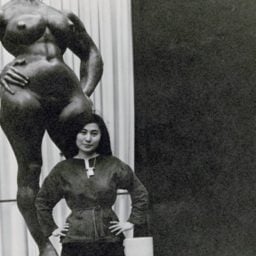
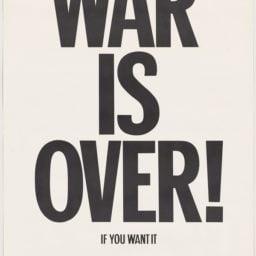
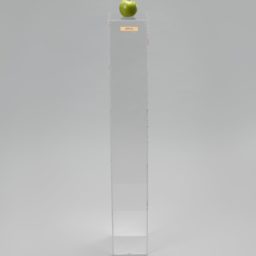
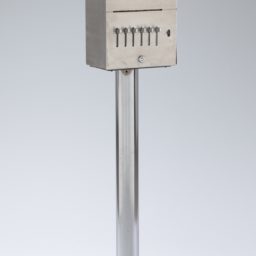
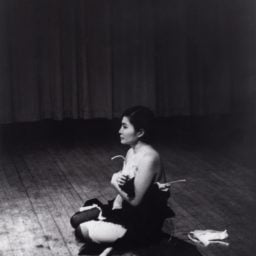
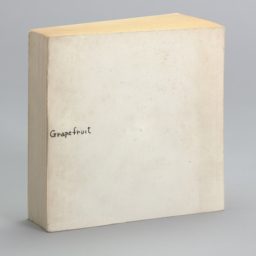
“Yoko Ono: One-Woman Show, 1960-1971” arrives at the Museum of Modern Art pre-freighted with issues of art and celebrity that have dogged the institution of late (see Ladies and Gentlemen, the Björk Show at MoMA Is Bad, Really Bad). It is guaranteed big press and big crowds, but probably not for the right reasons; not because of the fascination of Ono’s fundamental, definitive contributions to the history of Conceptual art and performance, but because of the man she married—a disheartening fate for a figure whose work has so much importance to feminist art.
There are more or less two obvious ways to react to this. You can reject Yoko-mania as being displaced Beatle-mania; or you can, more promisingly, reject the media cult as irrelevant to the virtues of the work on view—though this last approach probably consigns her collaborations with John Lennon, which end this show, to the status of embarrassing novelty.
I want to argue for a third approach: That “One-Woman Show” illustrates how issues of celebrity and media are baked into her work from the beginning.
The MoMA exhibition, curated by Christophe Cherix and Klaus Biesenbach, wisely narrows the focus to dwell on Ono’s most-fertile 1960s period. Its heart is where it should be: With Grapefruit, her beloved 1964 book, its pages featuring witty, mind-expanding instructions for actions one could perform (“Imagine your body spreading rapidly all over the world like thin tissue/Imagine cutting out one part of the tissue”), the typewritten proofs of which are shown along the wall; and with Cut Piece, the unsettling, endlessly influential 1965 performance for which the artist sat onstage, regally impassive, and invited audience members to sheer away her clothing, shown in a looping black-and-white 16mm film, shot by Albert and David Maysles.
“One-Woman Show” kicks off, chronologically, with documentation relating to Ono’s Chambers Street Loft, where she hosted a performance and art series with composer La Monte Young over six months in 1960-61. The space became a hub for budding multi-disciplinary experimentalists, and it was in that environment that Ono tested out her first interactive work: for instance, Painting to Be Walked On, recreated here as an irregular flap of canvas, laid on the floor so that you can, well, walk on it.
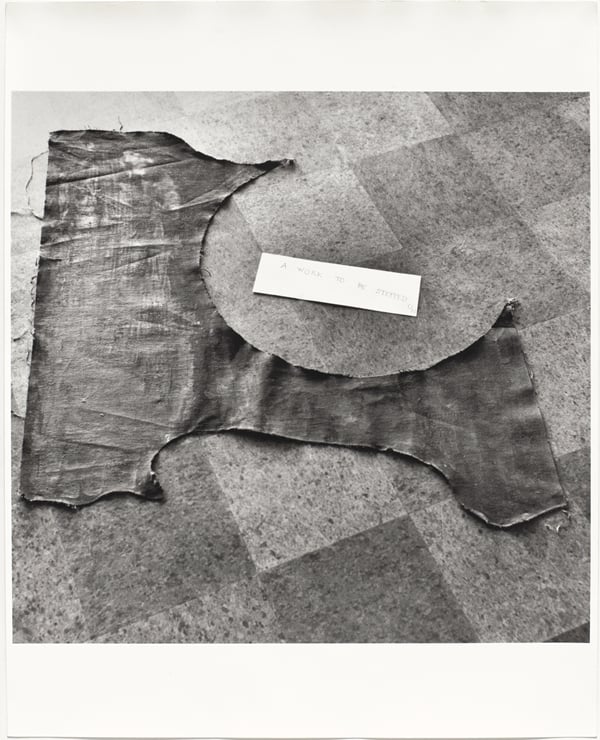
Painting to Be Stepped On. 1960/1961.
Photograph by George Maciunas.
The Museum of Modern Art, New York.
The Gilbert and Lila Silverman Fluxus Collection Gift, 2008.© 2014 George Maciunas
“On any given evening,” a wall text in the Chambers Street section informs us, “there were as many as 200 attendees, including art-world figures such as John Cage, Marcel Duchamp, Peggy Guggenheim, Isamu Noguchi, George Maciunas, Jasper Johns, and Robert Rauschenberg.” Such a label might seem a bit like the institutional equivalent of name-dropping, but it has the virtue of placing Ono’s art in a very specific place and time.
It was in this early-60s period, Lawrence Alloway once argued, that art became self-conscious of itself as a “world,” partly through the new press fascination with cool, media-smart neo-Dada figures like Johns and Rauschenberg and the market frenzy around Pop art. There was a corresponding shift in the ideal image of the artist, from loner in the studio to scenester—a condition that was as new for art as the media-driven youth-culture frenzy for the Beatles was for music.
Having a scene to activate the work of art is the basic assumption of Ono’s pioneering concept of “license,” that an artwork could be thought of as a social scenario to be completed by a viewer. This is art gains value not through contemplation but through becoming a social event; an art not just of looking but of being looked at.
Her innovations, then, fit neatly into the juncture between the traditional avant-garde and an ascendant media culture. MoMA contains a too-partial recreation of the 1966 London show at Indica gallery, which also happens to be where she first met John Lennon, then at the height of his fame—the Beatles had just retired from touring following Help! and were about to take their arty turn in Sgt. Pepper’s Lonely Hearts Club Band. Ono was 33, an artist who had the conviction of a creative and spiritual mission, and the show was bristling with ideas for activating the viewer.
These included Painting to Hammer a Nail (1961/1966), a simple board that was completed by a viewer obeying the titular command, and Ceiling Painting (1966), a white ladder that allowed you to ascend and view, through a magnifying glass, the word “YES” on a suspended canvas.
At MoMA, neither of these pieces are actually participatory, prominently equipped with “Please Do Not Touch” cards. You therefore cannot experience exactly the aspect of these artworks that is meant to be their primary animating interest. From an art that needs to be completed by the viewer we move into an art that is completed by the viewer’s knowledge of the story around Ono; the logic of direct experience becomes the logic of vicarious experience; concept-driven art crosses over into an aesthetics of celebrity memorabilia.
To be fair, however, Ono was wise to this game. The work in the show that provides its bookending date of 1971 bears the pleasantly juvenile title Museum of Modern (F)art. For this, Ono would make a book documenting a “one-woman show” at the MoMA that never happened, for which she proposed releasing a swarm of flies into the museum. She then took out an ad in the Village Voice touting it, and made a film of people on the street, interviewing them about their opinions about a show that hadn’t happened. Here, the whimsical underlying proposition doesn’t even need to be actualized—as long as the artist can activate the enabling aura of media notoriety.
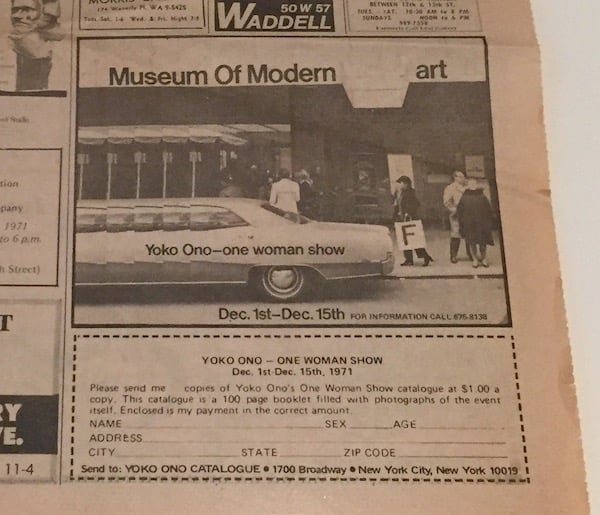
Ad for Yoko Ono’s “Museum of Modern (F)art” show in the Village Voice, on view in “Yoko Ono: One-Woman Show”
Photo: Ben Davis
Remembering Yoko Ono’s towering reputation in the experimental scene of New York’s ’60s, fellow feminist art icon Carolee Schneemann once said this of her pairing with Lennon: “[F]rankly, we all wondered if this… this… rock and roll guy was going to be smart enough for her.”
This MoMA show has its highs (a recreation of her 1967 “Half-a-Room” show at Lisson, featuring an array of household objects—a chair, a painting, all cut cleanly in half down the center) and lows (a brand new work consisting of a wobbly black spiral staircase that allows visitors to wait in a line to go up to the ceiling of the MoMA galleries and see exactly nothing), but I think it gets the balance of Lennon-orabilia about right. Lennon is confined to a listening gallery where you can enjoy the chaotic art-pop of the duo’s Plastic Ono Band; a giant projection of Film Number 5 (Smile) (1968) showing the long-haired rocker smiling in Warholian super-slow-mo; and a single graphic from their “War Is Over (If You Want It)” media campaign (ca. 1972), a well-meaning but vacuous slogan made bathetic by endless repetition.
I admit, however, that I have a soft spot for their Bed-In for Peace, shown here as an hour-long video on a monitor at the far end of the galleries. The event, for which the duo transformed their 1969 honeymoon into a press-baiting teach-in on non-violence, holding court in their Amsterdam hotel, is such an iconic pop-culture moment that one almost passes it by—yet at the end of “One-Woman Show” you do see it differently.
You can agree or disagree with the conviction of their utterly abstract political musings (I somehow had not realized that they were as much lecturing anti-war protesters to stay peaceful as they were taking a stand against government policy in Vietnam). But here, the celebrated spectacle appears as the logical offshoot of Cut Piece, the couple’s intimate bodies as the screen for the public to batter against, the hectoring cameras and questions having replaced the cutting shears.
Lennon is by far the more voluble of the two. Even so, I think you do not see Ono as an appendage of his fame. You see, instead, his fame as a vehicle for her to realize the role that her art had already been laying the ground for, of the artist as guru.
“Yoko Ono: One-Woman Show, 1960-1971” is on view at the Museum of Modern Art though September 7, 2015.